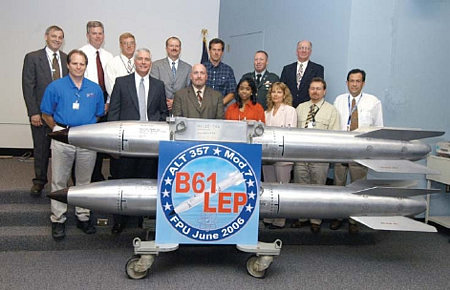Additional Delays Expected in B61-12 Nuclear Bomb Schedule

The B61-7, which completed a limited life-extension program in 2006, will be retired by the more extensive B61-12 program.
By Hans M. Kristensen
The National Nuclear Security Administration (NNSA) expects additional delays in production and delivery of the B61-12 nuclear bomb as a result of so-called sequestration budget cuts.
During testimony before the Hours Energy and Water Subcommittee last week, NNSA’s Acting Administrator Neile Miller said an expected $600 million reduction of the agency’s weapons activities budget could “slow the B61-12 LEP” and other weapons programs.
The Nuclear Posture Review set delivery of the first B61-12 for 2017, but that timeline has since slipped to 2019. Miller did not say how long production could be delayed but it could potentially slip into the 2020s.
The B61 LEP is already the most expensive and complex warhead modernization program since the Cold War, with cost estimates ranging from $8 billion to more than $10 billion, up from $4 billion in 2010. The price hike has triggered Congressional questions and efforts to trim the program. B61-12 proponents argue the weapon is needed to provide extended nuclear deterrence to NATO and Asian allies, but the mission in Europe is fading out and a cheaper alternative could be to retaining the B61-7 for the B-2A bomber and retire other B61 versions.
The B61-12 program extends the life of the tactical B61-4 warhead, incorporates selected components from three other B61 versions (B61-3, B61-7, and B61-10), adds unknown new safety and security features, and adds a guided tail kit to increase the accuracy and target kill capability of the B61-12 compared with the B61-4.
This publication was made possible by a grant from the Ploughshares Fund. The statements made and views expressed are solely the responsibility of the author.
The FY2026 National Defense Authorization Act (NDAA) paints a picture of a Congress that is working to both protect and accelerate nuclear modernization programs while simultaneously lacking trust in the Pentagon and the Department of Energy to execute them.
While advanced Chinese language proficiency and cultural familiarity remain irreplaceable skills, they are neither necessary nor sufficient for successful open-source analysis on China’s nuclear forces.
Satellite imagery has long served as a tool for observing on-the-ground activity worldwide, and offers especially valuable insights into the operation, development, and physical features related to nuclear technology.
This report outlines a framework relying on “Cooperative Technical Means” for effective arms control verification based on remote sensing, avoiding on-site inspections but maintaining a level of transparency that allows for immediate detection of changes in nuclear posture or a significant build-up above agreed limits.